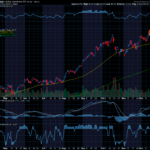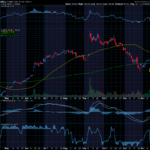by Thomas DeMark
An option contract holder is bestowed with three choices – exercise the option, let the option expire, or trade the option. But how does a trader decide which of the three alternatives to choose? A large portion of this decision is contingent upon the value of the option contract (or lack thereof) as well as the amount of time remaining before the option expires. When an option lacks value, meaning it is out-of-the-money, the trader can simply let the option expire worthless. When an option has value, meaning it is in-the-money, the trader can choose whether to trade the contract to another individual or exercise the contract and obtain the underlying asset. The ultimate decision that is made depends upon the individual investor, his or her trading style, trading needs, and the situation at hand.
Exercise the Option
As we just mentioned, one will only exercise a long option contract when one stands to make money from that position, otherwise one could simply let the option expire and lose the premium. (Please Note: There are instances in which this is not necessarily the case, such as when an investor is exercising a large quantity in an illiquid market, but such cases are rare). When an option buyer exercises an option, he or she is choosing to take a position in the underlying instrument. Naturally, the position is determined by the option type and whether it is a call or a put. In exercising a stock or futures call option, the holder agrees to purchase the standardized quantity of the underlying asset from the option writer at the predetermined strike price. Because of their contract, the writer is obligated to sell the asset to the buyer at the strike price, regardless of the price at which the market is currently trading. This transaction gives the buyer a long position in the asset and gives the writer a short position in the asset. Also note that while options provide the right to acquire the underlying instrument, the owner must still produce the necessary funds for the asset itself.

Exercising an index option, be it a call or a put, is handled differently because index options are settled in cash as opposed to the physical asset. When a call option buyer or a put option buyer exercises an index option, the holder is simply credited the amount by which the option is in-the-money, less any commission that applies. On the other hand, the call option writer or the put option writer is debited the amount by which the option is in-the-money, plus any commission that applies. For obvious reasons, an index option holder would choose to exercise his or her position only if it were profitable to do so, meaning if the contract were in-the-money.
The majority of index options today are European-style options, meaning that exercise can only occur at the end of the contract’s life. However, the most widely traded index option, the OEX Index option which covers the S&P 100, is an American-style contract, meaning exercise can occur at any point during the life of the option.
On the whole, most traders choose not to exercise an option prior to expiration. Doing so only entitles the investor to the intrinsic value of the option and sacrifices the added effect in time value. Exercising one’s option before the expiration date is not common when it comes to futures. Unless the option is deep in-the-money, where time value has a much lower impact, it generally makes more sense to trade out of the position. Exercising before the expiration date does occur more frequently when it comes to equity call options. Because option holders are not entitled to cash dividends, call options are usually exercised right before a stock goes ex-dividend so no contract value will be lost.
Defining the Profit
In each of these cases, exercise will only occur when it is profitable to do so – when the option is in-the-money. However, any time an individual exercises an option, that individual loses the full cost of the premium. Because of this, any gains on the trade will be offset by the losses on the cost of the option. One does not really make a profit on the transaction until the premium is recovered. Therefore, there is a break-even point that occurs with options that are exercised.
With call options, the break-even point occurs when the underlying asset has increased in price to a point where the intrinsic value is equal to the initial cost of the option. In other words, the strike price of the option plus the call premium. Any price above this break-even point would produce a profit on the transaction, if exercised, and any price below this break-even point would produce a loss on the transaction, if exercised.
With put options, the break-even point occurs when the underlying asset has decreased in price to a point there the intrinsic value is equal to the initial cost of the option. In other words, the strike price of the option minus the put premium. Any price below this break-even point would produce a profit on the transaction, if exercised, and any price above this break-even point would produce a loss on the transaction, if exercised.
Trade the Option
The second choice the holder of an option can make is to trade out of the option position before the option expires. Trading one’s option is exactly the same as trading any other asset. To close out a position, one must perform the opposite side of the trade in the same asset. To offset a long option position, be it a call or a put, the holder must sell an option of the same type, expiration month, and strike price. To offset a short option position, be it a call or a put, the holder must buy an option of the same type, expiration month, and strike price. When one initiates a long option trade, the premium that is paid for the option is the entry price and when one liquidates a long option trade, the premium that is received for the option is the exit price. Obviously, if the exit price is greater than the entry price, the holder will profit on the trade. When one initiates a short option trade, the premium that is received for the option is the entry price and the premium that is paid for the option is the closing price. In this case, if the exit price is less than the entry price, the writer will profit on the trade.
Trading versus Exercising
There is a common misconception that the most profitable way to make money with options is by exercising the contract when it is in-the-money, when in reality, trading out of one’s option can be far more lucrative. There are three reasons why this is so. The primary reason is that exercising an option can only provide the investor with the intrinsic value of the trade, while trading an option position can entitle the investor to the intrinsic value as well as additional time value. How much more the time value will provide is determined by factors such as time to expiration, volatility, dividend rates, and interest rates. A second reason is that trading one’s position does not force the option buyer to incur the full cost of the premium, which is what occurs when one exercises an option. Since the gains from trading an option are not used to cover the cost of the premium, there is no break-even point, there is simply the entry price and the exit price. Finally, by trading out of one’s option(s), the trader saves on commission costs. This is particularly helpful when a trader has a large option position.
Let the Option Expire
A final alternative available to the option holder is to let the option expire. Simply put, the trader can do nothing with the option and lose only what he or she paid in premium. Naturally, an option buyer will only let the contract expire if it lacks value at expiration, meaning it is out-of-the-money. Once the expiration occurs, the option buyer no longer controls the underlying asset and loses all rights conveyed by the contract. Doing nothing is a luxury that is afforded only to option traders. This eliminates the necessity of offsetting a losing position, thereby serving as an inherent stop loss on the trade. Trading any other type of asset obligates the investor to eventually offset the position, regardless of whether it is profitable to do so.
Example of Exercising versus Trading
Let’s take a look at an option example and the alternatives an option buyer possess. In February, a trader buys 1 IBM May 110 Call at $5 when IBM is trading at $108 per share. In late April, when the option is nearing expiration, IBM stock is trading around $120 per share and the option’s premium has increased to $11 ½. In this example, because the option is in-the-money, the option holder has the choice of either exercising the option contract or trading out of the long call position. If the trader decides to exercise the IBM May 110 Call option contract, he or she must first inform the clearing firm of their intentions. The clearing firm then notifies an IBM May 110 call writer that they have been exercised and is obligated to sell 100 shares of IBM stock to the option holder at a price of $110 per share. (Please Note: The option writer who has been exercised is not necessarily the trader who initiated the option transaction with the option buyer in the first place. The clearing firm decides how it will match option buyers and sellers. It is important that a trader is aware of the method the firm chooses before he or she decides to write an option contract). The option buyer then pays the option writer $110 per share for the 100 shares of IBM, for a total of $11,000, giving the trader a long stock position at $110 when the market is trading $10 higher. In exercising the long call contract, the trader paid $500 for the rights to the option and $11,000 for the 100 shares of IBM stock, for a total cost of $11,500 on the transaction. If the trader were to immediately liquidate this long IBM stock position, by selling 100 shares of IBM at $120, the trader would receive a total payment of $12,000. Therefore, on the overall transaction, the trader realizes a total profit of $500 ($12,000 – $11,500), excluding any commission costs necessary to purchase the call option, to purchase the 100 shares of IBM stock, and to sell the 100 shares of IBM stock.
On the other hand, if the trader were to trade out of this long IBM call option position by performing an offsetting transaction, the process would be much simpler. To offset the long IBM May 110 Call option position, the trader must sell 1 IBM May 110 Call option. With the prevailing market prices, the option buyer paid $5, or $500, for the rights to the call option and can sell the option at $11 ½, or $1,150. Therefore, the option buyer realizes a total of $650 of profit on the trade, less any commission that applies for purchasing the call option and later liquidating that option.
In comparison, by trading out of the option position the option holder was able to realize a greater profit on the trade. This is usually the case with options. However, the closer to expiration the option gets, the less a trader will be able to retrieve in premium by trading out of his or her position. It is important that a trader compare the two processes before making a decision as to what to do with the option position.











Recent Comments